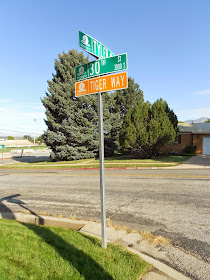Devil’s Slide today.
DEVIL'S Slide is a bizarre, giant-size limestone chute, located
on the south side of I-84 in Weber Canyon, near Croydon, and about eight miles
east of Morgan.
Composed of two parallel slabs of rock about 20 feet apart, some
40 feet high and about 200 feet long, this odd phenomenon has attracted the
curious gaze of passerbys since Pioneer times.
The first pioneers through the area in the 1840s (and their
maps) referred to the Croydon area of upper Weber Canyon as “Gutter Defile,” in
honor of what would eventually become famous as Devil’s Slide.
Who named the rock formation Devil’s Slide?
James John Walker (1830-1896), an early resident of Croydon and
a railroad worker, is very likely the first person to have called it Devil’s
Slide.
A Walker family history states that James Walker was a
contractor on the railroad, installing the first tracks through upper Weber
Canyon. Probably around 1868, he was asked (being a local resident) by a
railroad crew what to call this unusual rocky chute and his reply was Devil’s
Slide and the title stuck.
The first official mention of that name for the rock formation in
a newspaper was in 1875.
"Looking like a large playground slide fit
only for the Devil, this site is a tilted remnant of sediments deposited in a
sea that occupied Utah's distant geologic past," Carl Ege of the Utah
Geological Survey explains on geology.utah.gov.
By 1904, limestone was found in abundance in the area of Devil’s
Slide and soon a cement worker’s town sprung up there. Workers initially began
calling the new community Portland, in honor of the Union Portland Cement
Company.
However, railroad people objected to that name and insisted on a
Devil’s Slide moniker instead. They won out and by 1907 the local post office
was also called Devils Slide. (Note that there was no apostrophe to the town's name.)
The cement company’s packages even sported the startling image
of the devil sliding down the rock chute on his pitchfork for many years. The
company’s baseball team was also called the Red Devils.
The town reached its heyday in the late 1920s, before the Great
Depression, when it boasted 529 residents. By the 1940s, its school closed and
by the 1980s, only a few families still resided there. Soon after, the cement
company closed the town and today a gravel pit and rubble mostly cover what remains
of this ghost town.
A 1947 photo of Devil’s Slide shows visitor Venice Carson Flygare of Grouse Creek/Ogden. Note how close the viewpoint to the Slide was back then, in the pre-freeway era.
Going back in time again, “Mystic Shriners at Devil’s Slide” was
an Aug. 22, 1911 headline in the Standard, The Shriners held special ceremonies
and initiations around the formation. Included was a hike to the top of Devil’s
Slide, followed by an optional, daring slide downward.
Did this really happen? Perhaps, but the natural rock slide ends
dozens of feet away from the Weber River, which is why a special pool of water was
apparently set up at the bottom by the Shriners.
“Devil’s Slide jinks
success; El Kalah Temple Mystic Shrine holds unique ceremonial at that spot;
Novices slide incline into fathomless pool” ” was a Sept. 16, 1910 headline in
the Salt Lake Tribune, showing they had also used the Slide a year earlier.
Several hundred Shriners took a special train to the Slide and
even set up tents in the area. Sliding down the Slide was also featured that
year.
Ogden began promoting Devil’s Slide as a tourist attraction in
the mid 1920s, with signs. Devil’s Gate, at the lower end of Weber Canyon, was
also boasted of in numerous Standard-Examiner reports of the 1920s.
Today, there are posted turnouts to view the slide just off both
directions of I-84. However, in the pre-freeway era, a 1947 picture of Devil’s
Slide shows the viewing area much closer to the formation than it is today.
Back then, the dirt access road (in front of Devil’s Slide today) may have
been the main road before the Interstate came along.
Now, the slide’s bottom is choked with brush and some private
land fronts the Slide.
Hauntingly, there are also "Witch
Rocks" and the small "Goblin Slides" rock formations in the same
area of upper Weber Canyon.
The Salt Lake Tribune ran a story on June 28, 1888 that told the
tale of an out-of-stater fishing the Weber River in that area with an Indian
guide. This Native American believed the area to be the Devil’s territory and
even pointed out another nearby rock formation that was said to be the “Devil’s
War Club.”
-As unusual as the Top of Utah’s Devil’s Slide may seem, it is
not unique. There is a same-named and similar rock formation about five
miles north of Gardiner, Mont. Just north of Yellowstone National Park, off
U.S. 89, this Devil's Slide, though has a twist — a big curve in its slabs of parallel
rock.
(-Originally published in the Ogden Standard-Examiner on Sept. 26, 2014 by Lynn Arave.)
-NOTE: The author, Lynn Arave, is available to speak to groups, clubs, classes or other organizations about Utah history at no charge. He can be contacted by email at: lynnarave@comcast.net






.jpg)